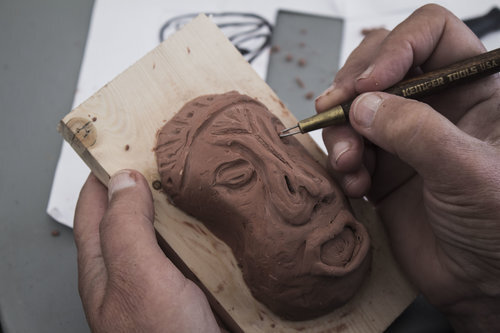FESTIVAL CARVER
BY RACHEL DALE
Over the course of the weekend, visual artist Ken Anderson held workshops at the Atlin Arts and Music Festival as a way to share his traditional Tlingit art forms with festival-goers. Anderson’s art varies depending on the type of piece a customer is looking for, including painting and carving with different mediums – from stone to bronze to steel to wood.
For Anderson, art was always a hobby. He studied traditional and contemporary art from the 1990s, which he found an interest in fusing together. As a resurgence of Indigenous art began, his interest in Tlingit art grew stronger.
“First Nations people became more recognized,” he says. “Things like land claims started to come to the forefront. There was a revitalization of the culture. Art is a huge part of the culture.”
While Anderson typically finds inspiration in stories and places, his favourite pieces are the ones that are made specifically for someone.
“I think when you can do work that’s made for somebody, that makes it really special,” Anderson says. “That was the traditional way things were done, where people would ask the artist to do things for them and it was kind of a working relationship.”
At the festival, Anderson had his students create small and simple pieces as an introduction to the kind of art he has been doing professionally for the last 20 years. For his first workshop, students created small masks out of Styrofoam and clay. In only two and a half hours, Anderson wanted them to experience his art as a culture.
“I think the more we understand about each other, the different groups of people, the more we realize our similarities,” he says. “That’s part of what art is. It’s sharing the culture.”
Anderson doesn’t want students to recreate the art he has already done. Instead, he wants to show them the skills to achieve their own sense of personality and individuality in their artwork.
“It’s a universal thing called creativity,” Anderson says. “We kind of all evolved in different ways but we’re all similar in many ways. That’s the beauty of sharing art with other people, especially if it’s from a cultural background.”
Holding the workshops at the festival wasn’t Anderson’s idea, but when the organizers asked him, he felt the opportunity was an honour.
“I think I have a responsibility,” he says as he describes his workshops. “I’m representing the culture, representing my clan, representing my First Nation. You just do the best work that you can.”



